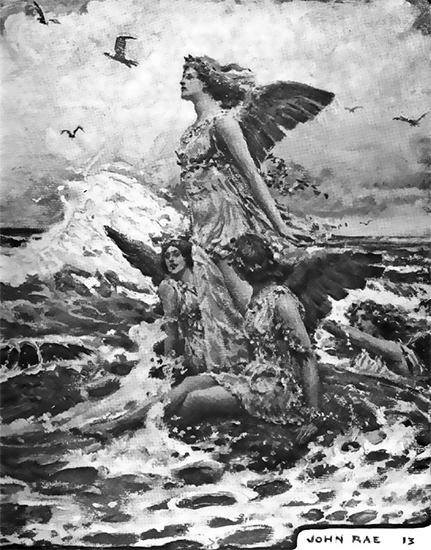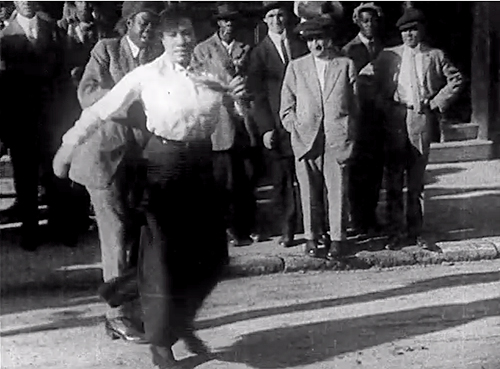Introduction and Table of Contents
| 1914 Time Capsule Street Scene on the Barbary Coast 1914 Slideshow, pt 1 The Muses on the Hearth Black Couples Dance in the Street 1914 Slideshow, pt 2 Associated Content in Previous Issues Period Responses to The Birth of a Nation 1914 Women in Film Suite |
|
In association with our presentation of three 1914 women filmmakers in Blackbird v13n2 and leading up to 1915’s “Period Responses to The Birth of a Nation” in v14n1, Blackbird sampled texts and images from publications of 1914.
“Sampled” is used here to suggest an eclectic exploration of the digital archives; we didn't go in with a predetermined argument in mind, though we hoped to discover texts and images that resonate with contemporary concerns.
We were not disappointed.
Perusing mostly serial publications of 1914, we recognized familiar literary voices in the mix at the rise of Modernity and included in our slideshow a few glimpses of work by known writers, including Amy Lowell, William Butler Yeats and James Joyce. But we also were interested in the names that we had not heard, Inez Gilmore, James E. Richardson, Lucy Reynolds, and F.G. Allison among them, individuals who appear more tenuously and then disappear again, if not from publication in their time, then at least from general knowledge.
Poety is evidently hot in 1914. The Editor, “a journal of information for literary workers,” quotes Macmillan Company President, George P. Brett, as saying, “To-day a real poet, can no longer lament the fact that he cannot extract a living from verse. These threadbare days are gone." Brett asserts that “for the first time since Tennyson the poets have broken into the ‘best-seller class’” with moving-pictures “displacing the novel for time-killing purposes.”
Poets in the contempary markeplace, at least, will find this amusing.
The start of WWI shows up here in some selections from The Masses. The state of Wisconson, in the meantime, championing eugenics, attempts to define marriage as being only between persons who are “fit to reproduce.” The terms feminist and feminism are in full use, and suffrage is a part of a larger discussion as evidenced by texts in Blast, Everybody's Magazine, The Masses, Gilmore’s feminist allegory Angel Island, and F.G. Alison’s “Muses on the Hearth,” (republished here in whole) a treatise on the role the university should play in the education of women.
 |
| (detail) Illustration of Angel Island in American Magazine, 1913. |
The three color illustrations that close Part One of the slideshow, from Inez Gilmore’s Angel Island, beg their own expanded notes here since they, without context, give an incomplete and romantized sense of the story. Now cited as early feminist—and early speculative—fiction, Angel Island is a novel—an allegory—in which five shipwrecked men find themselves on an island with five winged women who can only fly, their feet being too weak to allow them to walk. Advertised in The American Magazine, where it appears serially in 1913, the novel is described as
A wooing unparalleled in romance . . . A powerful, moving, exquisite presentation of the woman’s side of the great modern sex problem—the feminist fight for freedom.
On more than one front, we would certainly describe Angel Island in far different terms.
In what is essentially a rape scene, the men trap the five women and cut their wings from their bodies with shears, not knowing whether they will survive. This metaphorical representation of rape appeared recently in Disney’s film, Maleficent (2014), in which the character’s wings are cut from her body during a drugged sleep.
In Gilmore’s novel, the women subsequently pair off with the men and bear children but finally rebel when they learn of the men’s intent to cut the wings of the daughters—who have thus far been allowed to fly freely—when they turn eighteen. The women teach themselves, and their daughters, to walk, and even manage to fly again with the grown-out stubs of their wings; they corporately defy the men. At the novel’s close, fulfulling the hopes of the women, a boy with wings is born.
In both slideshows, we also present modernist art, political cartoons, poems whose sensibilities and language wobble between the nineteenth and twentieth centuries, “the horrors of vaccination,” labor unrest, and advertisers selling “purity” along with soup. Class, labor, and racial injustice all make an appearance as well.
Part two of the slideshow closes with images from the NAACP’s journal Crisis, which reports in every issue, alongside advances by Black Americans, racial brutality and charts of annual lynchings; a sobering check to any nostalgic longing for the era.
 |
| Gould, still from footage of street dancing, 1914 |
Mindful of this presentation in conversation with “Women in Film,” and “Period Responses to The Birth of a Nation,” we have included two short street scenes of silent documentary footage from 1914 as something of a couterpoint to staged representations on commercial film: this to put us more closely in mind to the living, breathing individuals of the period. The first footage is of a street scene in San Francisco, the second, by the same filmmaker at an undisclosed location, is of Black couples dancing in the street, both films courtesy of the Prelinger Archives.
We invite readers to consider period and contemporary connections through the materials we’ve curated here and urge everyone to follow up by exploring primary texts of the period through such resources as Google Books, the Internet Archive, and the Modernist Journals Project, all resources we tapped for this Time Capsule. For those who feel a stranger to this period, we predict that there will come the shiver of recognition for what has not yet been resolved in the American conversation across a dividing century. ![]()
return to top